Trade & International Business: FDI Theories, Costs, Benefits in Spain
VerifiedAdded on 2023/06/15
|14
|2788
|166
Report
AI Summary
This report provides an analysis of Foreign Direct Investment (FDI) trends in Spain, examining relevant theories such as the Eclectic FDI theory and the Life Cycle Theory to explain FDI patterns. It explores the costs and benefits of FDI for both the host and home countries, highlighting Spain's increased FDI inflow post-2000 and its positive impact on economic performance, including job creation and industrial growth. The analysis incorporates data from the World Bank and other sources to illustrate FDI's sectoral distribution and the contributions of various investing countries, concluding with a forecast suggesting continued growth in FDI inflows for Spain.
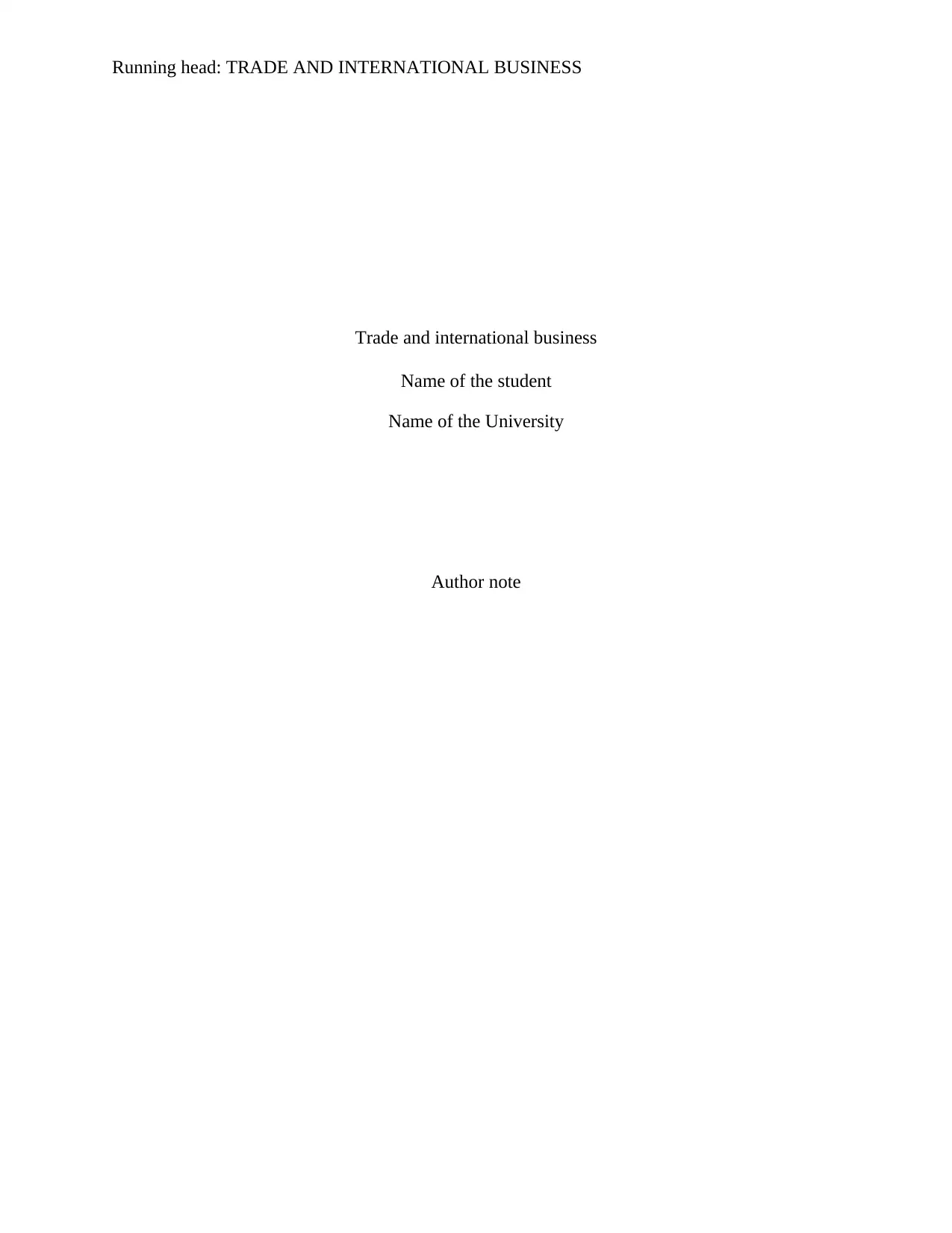
Running head: TRADE AND INTERNATIONAL BUSINESS
Trade and international business
Name of the student
Name of the University
Author note
Trade and international business
Name of the student
Name of the University
Author note
Secure Best Marks with AI Grader
Need help grading? Try our AI Grader for instant feedback on your assignments.
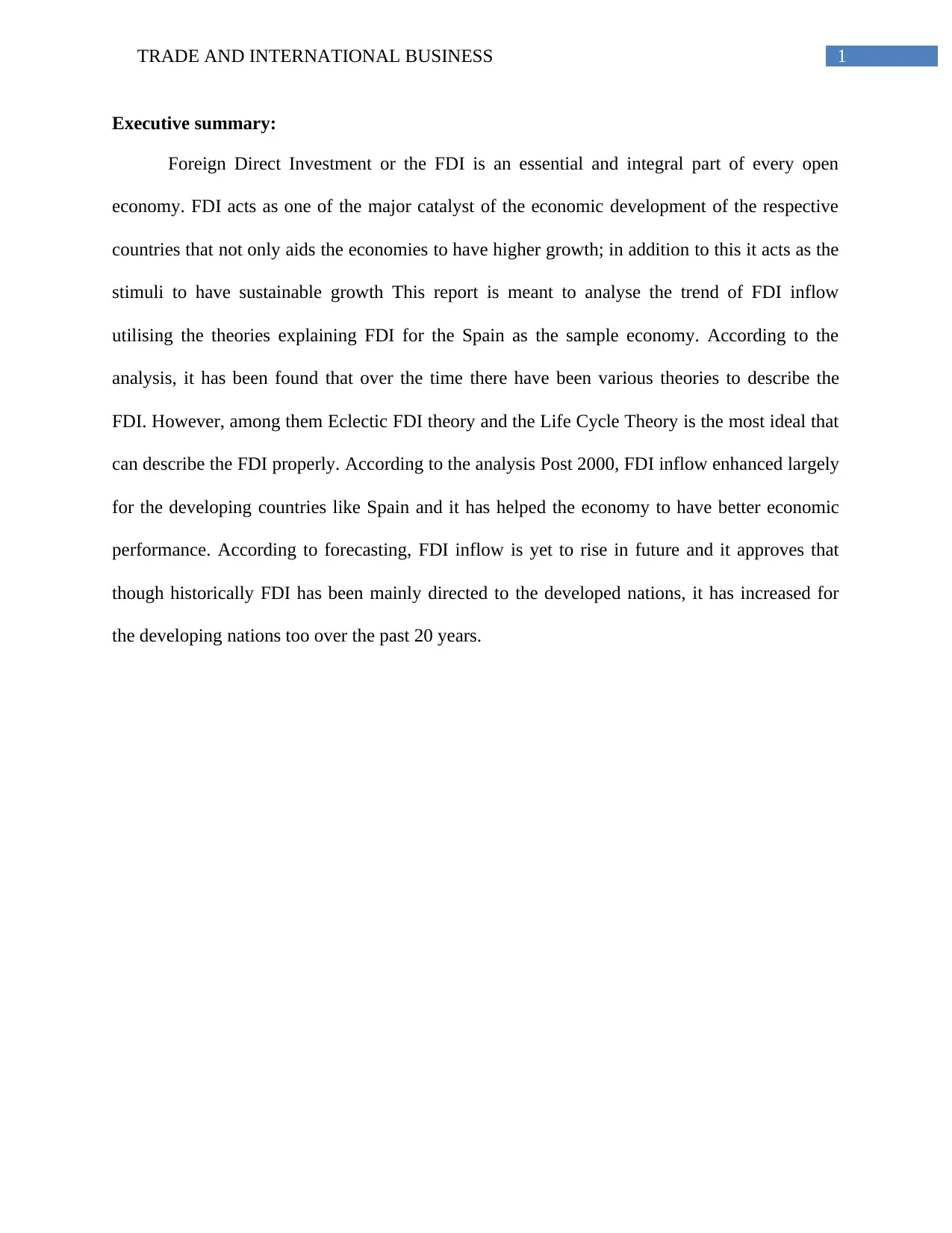
1TRADE AND INTERNATIONAL BUSINESS
Executive summary:
Foreign Direct Investment or the FDI is an essential and integral part of every open
economy. FDI acts as one of the major catalyst of the economic development of the respective
countries that not only aids the economies to have higher growth; in addition to this it acts as the
stimuli to have sustainable growth This report is meant to analyse the trend of FDI inflow
utilising the theories explaining FDI for the Spain as the sample economy. According to the
analysis, it has been found that over the time there have been various theories to describe the
FDI. However, among them Eclectic FDI theory and the Life Cycle Theory is the most ideal that
can describe the FDI properly. According to the analysis Post 2000, FDI inflow enhanced largely
for the developing countries like Spain and it has helped the economy to have better economic
performance. According to forecasting, FDI inflow is yet to rise in future and it approves that
though historically FDI has been mainly directed to the developed nations, it has increased for
the developing nations too over the past 20 years.
Executive summary:
Foreign Direct Investment or the FDI is an essential and integral part of every open
economy. FDI acts as one of the major catalyst of the economic development of the respective
countries that not only aids the economies to have higher growth; in addition to this it acts as the
stimuli to have sustainable growth This report is meant to analyse the trend of FDI inflow
utilising the theories explaining FDI for the Spain as the sample economy. According to the
analysis, it has been found that over the time there have been various theories to describe the
FDI. However, among them Eclectic FDI theory and the Life Cycle Theory is the most ideal that
can describe the FDI properly. According to the analysis Post 2000, FDI inflow enhanced largely
for the developing countries like Spain and it has helped the economy to have better economic
performance. According to forecasting, FDI inflow is yet to rise in future and it approves that
though historically FDI has been mainly directed to the developed nations, it has increased for
the developing nations too over the past 20 years.
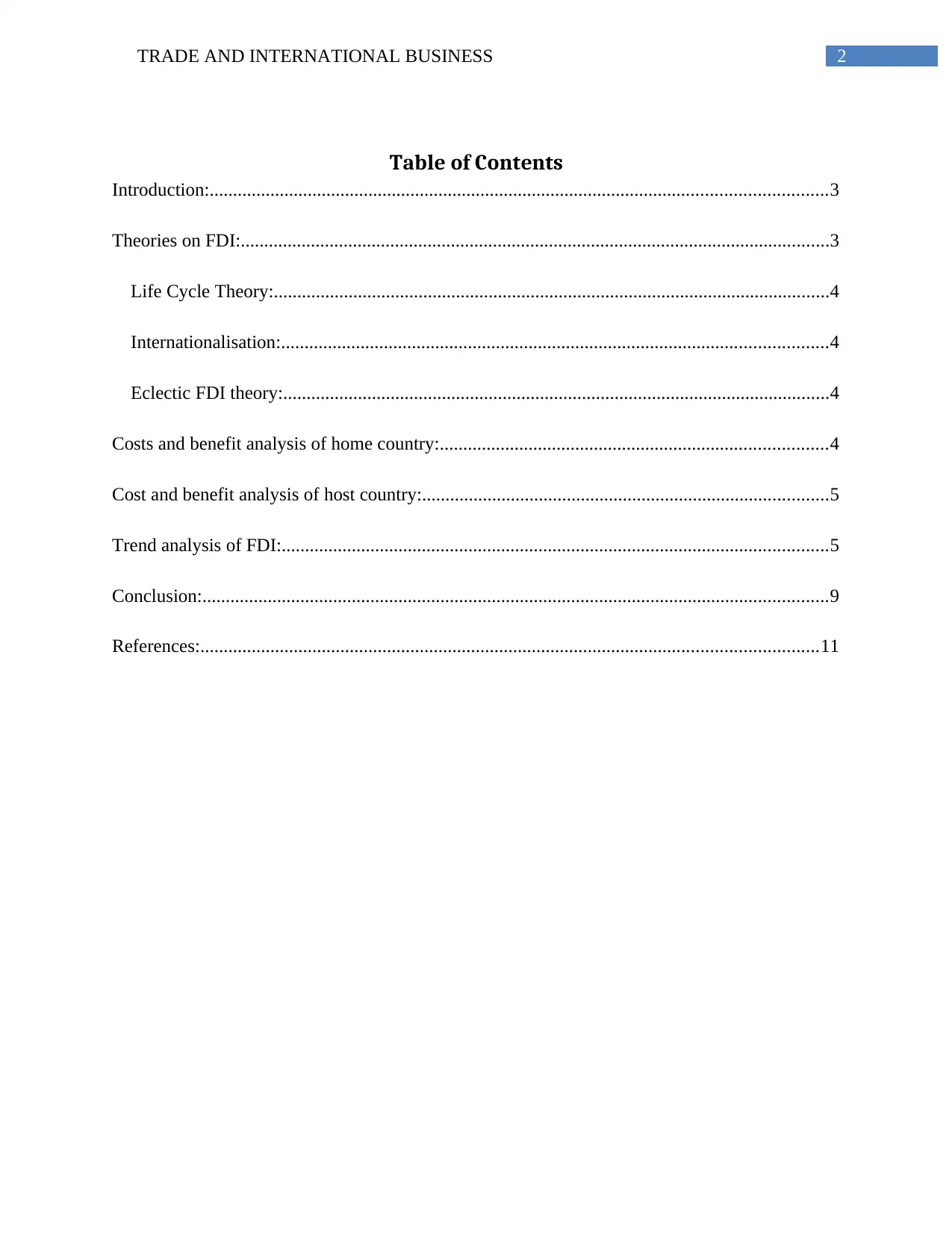
2TRADE AND INTERNATIONAL BUSINESS
Table of Contents
Introduction:....................................................................................................................................3
Theories on FDI:..............................................................................................................................3
Life Cycle Theory:.......................................................................................................................4
Internationalisation:.....................................................................................................................4
Eclectic FDI theory:.....................................................................................................................4
Costs and benefit analysis of home country:...................................................................................4
Cost and benefit analysis of host country:.......................................................................................5
Trend analysis of FDI:.....................................................................................................................5
Conclusion:......................................................................................................................................9
References:....................................................................................................................................11
Table of Contents
Introduction:....................................................................................................................................3
Theories on FDI:..............................................................................................................................3
Life Cycle Theory:.......................................................................................................................4
Internationalisation:.....................................................................................................................4
Eclectic FDI theory:.....................................................................................................................4
Costs and benefit analysis of home country:...................................................................................4
Cost and benefit analysis of host country:.......................................................................................5
Trend analysis of FDI:.....................................................................................................................5
Conclusion:......................................................................................................................................9
References:....................................................................................................................................11
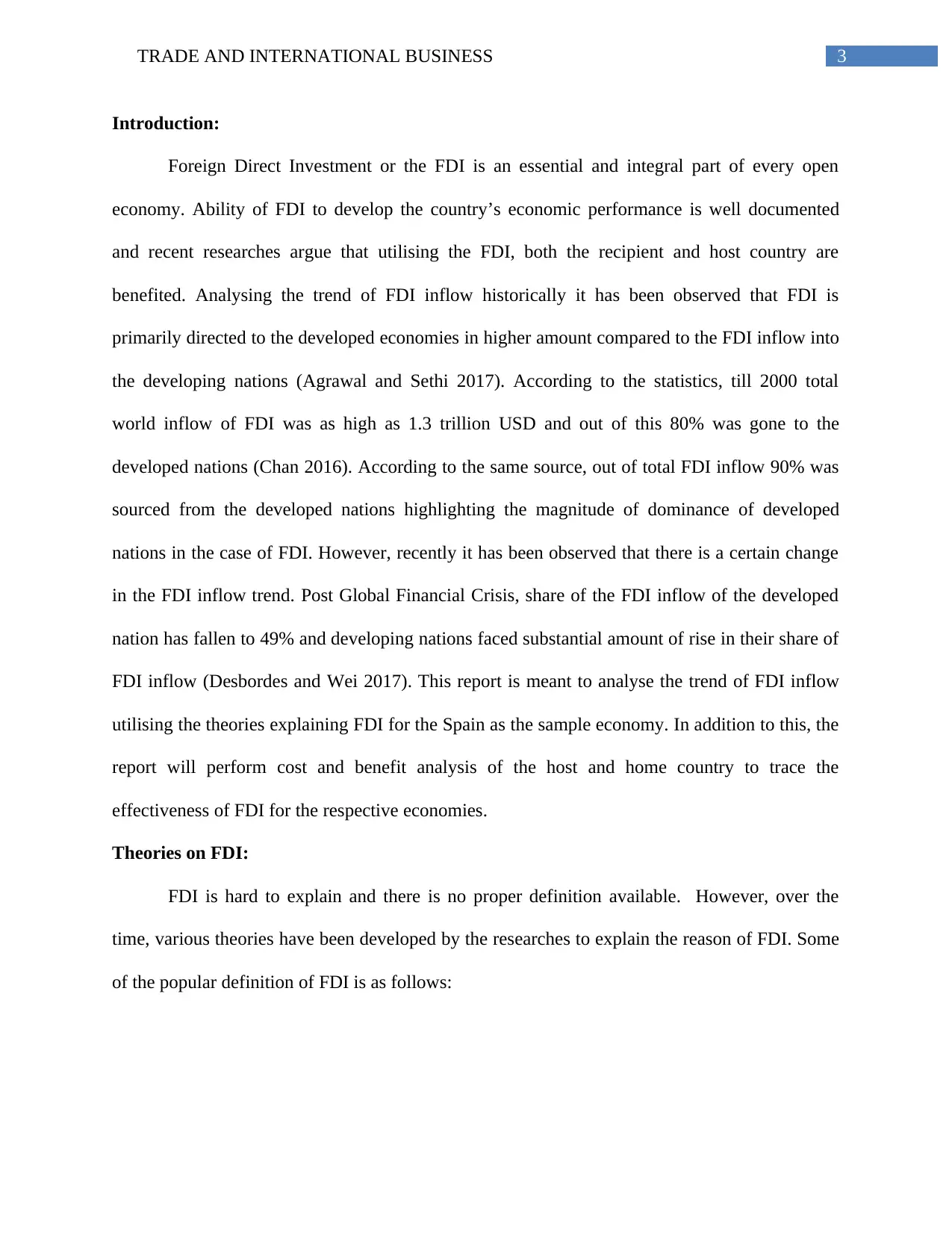
3TRADE AND INTERNATIONAL BUSINESS
Introduction:
Foreign Direct Investment or the FDI is an essential and integral part of every open
economy. Ability of FDI to develop the country’s economic performance is well documented
and recent researches argue that utilising the FDI, both the recipient and host country are
benefited. Analysing the trend of FDI inflow historically it has been observed that FDI is
primarily directed to the developed economies in higher amount compared to the FDI inflow into
the developing nations (Agrawal and Sethi 2017). According to the statistics, till 2000 total
world inflow of FDI was as high as 1.3 trillion USD and out of this 80% was gone to the
developed nations (Chan 2016). According to the same source, out of total FDI inflow 90% was
sourced from the developed nations highlighting the magnitude of dominance of developed
nations in the case of FDI. However, recently it has been observed that there is a certain change
in the FDI inflow trend. Post Global Financial Crisis, share of the FDI inflow of the developed
nation has fallen to 49% and developing nations faced substantial amount of rise in their share of
FDI inflow (Desbordes and Wei 2017). This report is meant to analyse the trend of FDI inflow
utilising the theories explaining FDI for the Spain as the sample economy. In addition to this, the
report will perform cost and benefit analysis of the host and home country to trace the
effectiveness of FDI for the respective economies.
Theories on FDI:
FDI is hard to explain and there is no proper definition available. However, over the
time, various theories have been developed by the researches to explain the reason of FDI. Some
of the popular definition of FDI is as follows:
Introduction:
Foreign Direct Investment or the FDI is an essential and integral part of every open
economy. Ability of FDI to develop the country’s economic performance is well documented
and recent researches argue that utilising the FDI, both the recipient and host country are
benefited. Analysing the trend of FDI inflow historically it has been observed that FDI is
primarily directed to the developed economies in higher amount compared to the FDI inflow into
the developing nations (Agrawal and Sethi 2017). According to the statistics, till 2000 total
world inflow of FDI was as high as 1.3 trillion USD and out of this 80% was gone to the
developed nations (Chan 2016). According to the same source, out of total FDI inflow 90% was
sourced from the developed nations highlighting the magnitude of dominance of developed
nations in the case of FDI. However, recently it has been observed that there is a certain change
in the FDI inflow trend. Post Global Financial Crisis, share of the FDI inflow of the developed
nation has fallen to 49% and developing nations faced substantial amount of rise in their share of
FDI inflow (Desbordes and Wei 2017). This report is meant to analyse the trend of FDI inflow
utilising the theories explaining FDI for the Spain as the sample economy. In addition to this, the
report will perform cost and benefit analysis of the host and home country to trace the
effectiveness of FDI for the respective economies.
Theories on FDI:
FDI is hard to explain and there is no proper definition available. However, over the
time, various theories have been developed by the researches to explain the reason of FDI. Some
of the popular definition of FDI is as follows:
Secure Best Marks with AI Grader
Need help grading? Try our AI Grader for instant feedback on your assignments.
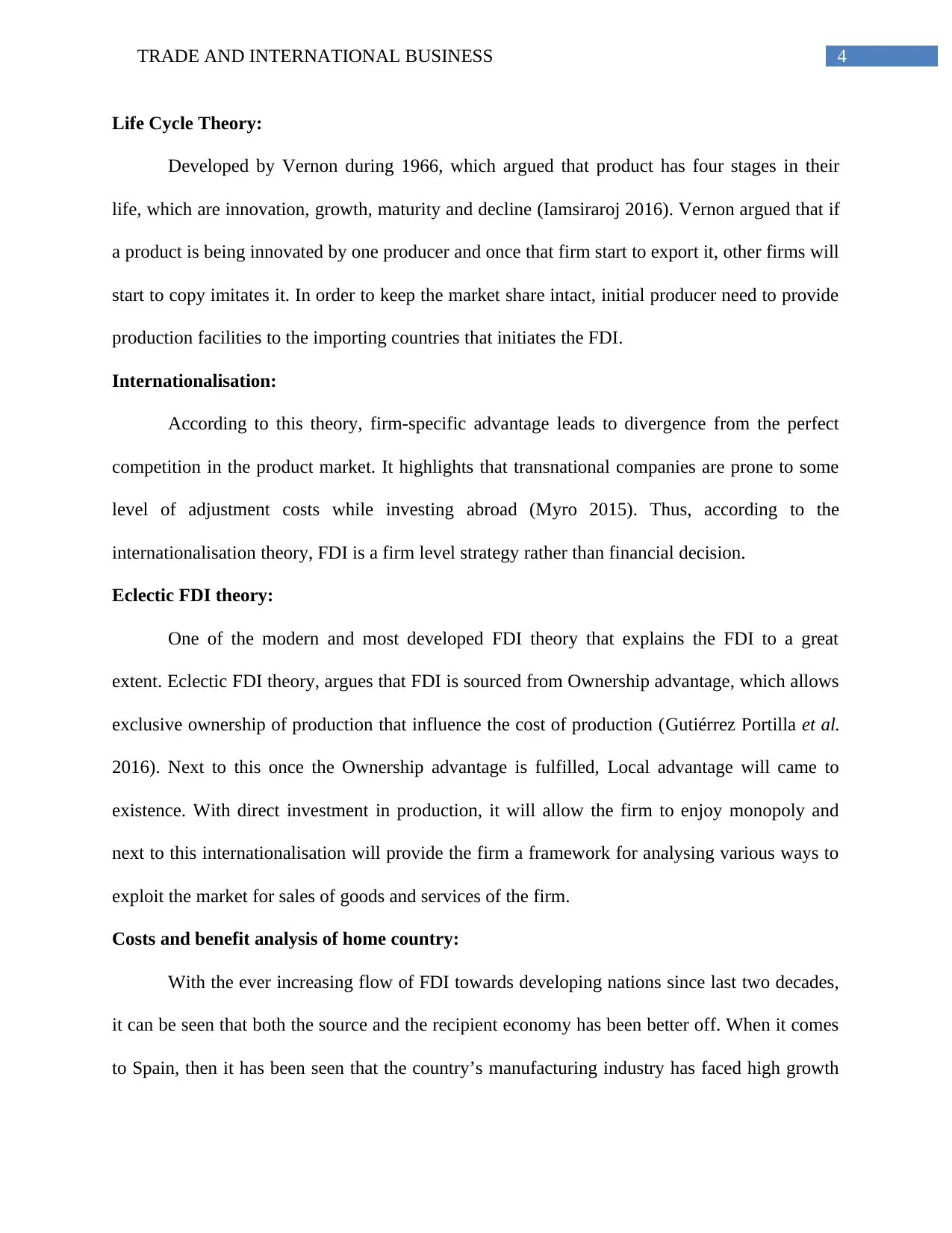
4TRADE AND INTERNATIONAL BUSINESS
Life Cycle Theory:
Developed by Vernon during 1966, which argued that product has four stages in their
life, which are innovation, growth, maturity and decline (Iamsiraroj 2016). Vernon argued that if
a product is being innovated by one producer and once that firm start to export it, other firms will
start to copy imitates it. In order to keep the market share intact, initial producer need to provide
production facilities to the importing countries that initiates the FDI.
Internationalisation:
According to this theory, firm-specific advantage leads to divergence from the perfect
competition in the product market. It highlights that transnational companies are prone to some
level of adjustment costs while investing abroad (Myro 2015). Thus, according to the
internationalisation theory, FDI is a firm level strategy rather than financial decision.
Eclectic FDI theory:
One of the modern and most developed FDI theory that explains the FDI to a great
extent. Eclectic FDI theory, argues that FDI is sourced from Ownership advantage, which allows
exclusive ownership of production that influence the cost of production (Gutiérrez Portilla et al.
2016). Next to this once the Ownership advantage is fulfilled, Local advantage will came to
existence. With direct investment in production, it will allow the firm to enjoy monopoly and
next to this internationalisation will provide the firm a framework for analysing various ways to
exploit the market for sales of goods and services of the firm.
Costs and benefit analysis of home country:
With the ever increasing flow of FDI towards developing nations since last two decades,
it can be seen that both the source and the recipient economy has been better off. When it comes
to Spain, then it has been seen that the country’s manufacturing industry has faced high growth
Life Cycle Theory:
Developed by Vernon during 1966, which argued that product has four stages in their
life, which are innovation, growth, maturity and decline (Iamsiraroj 2016). Vernon argued that if
a product is being innovated by one producer and once that firm start to export it, other firms will
start to copy imitates it. In order to keep the market share intact, initial producer need to provide
production facilities to the importing countries that initiates the FDI.
Internationalisation:
According to this theory, firm-specific advantage leads to divergence from the perfect
competition in the product market. It highlights that transnational companies are prone to some
level of adjustment costs while investing abroad (Myro 2015). Thus, according to the
internationalisation theory, FDI is a firm level strategy rather than financial decision.
Eclectic FDI theory:
One of the modern and most developed FDI theory that explains the FDI to a great
extent. Eclectic FDI theory, argues that FDI is sourced from Ownership advantage, which allows
exclusive ownership of production that influence the cost of production (Gutiérrez Portilla et al.
2016). Next to this once the Ownership advantage is fulfilled, Local advantage will came to
existence. With direct investment in production, it will allow the firm to enjoy monopoly and
next to this internationalisation will provide the firm a framework for analysing various ways to
exploit the market for sales of goods and services of the firm.
Costs and benefit analysis of home country:
With the ever increasing flow of FDI towards developing nations since last two decades,
it can be seen that both the source and the recipient economy has been better off. When it comes
to Spain, then it has been seen that the country’s manufacturing industry has faced high growth
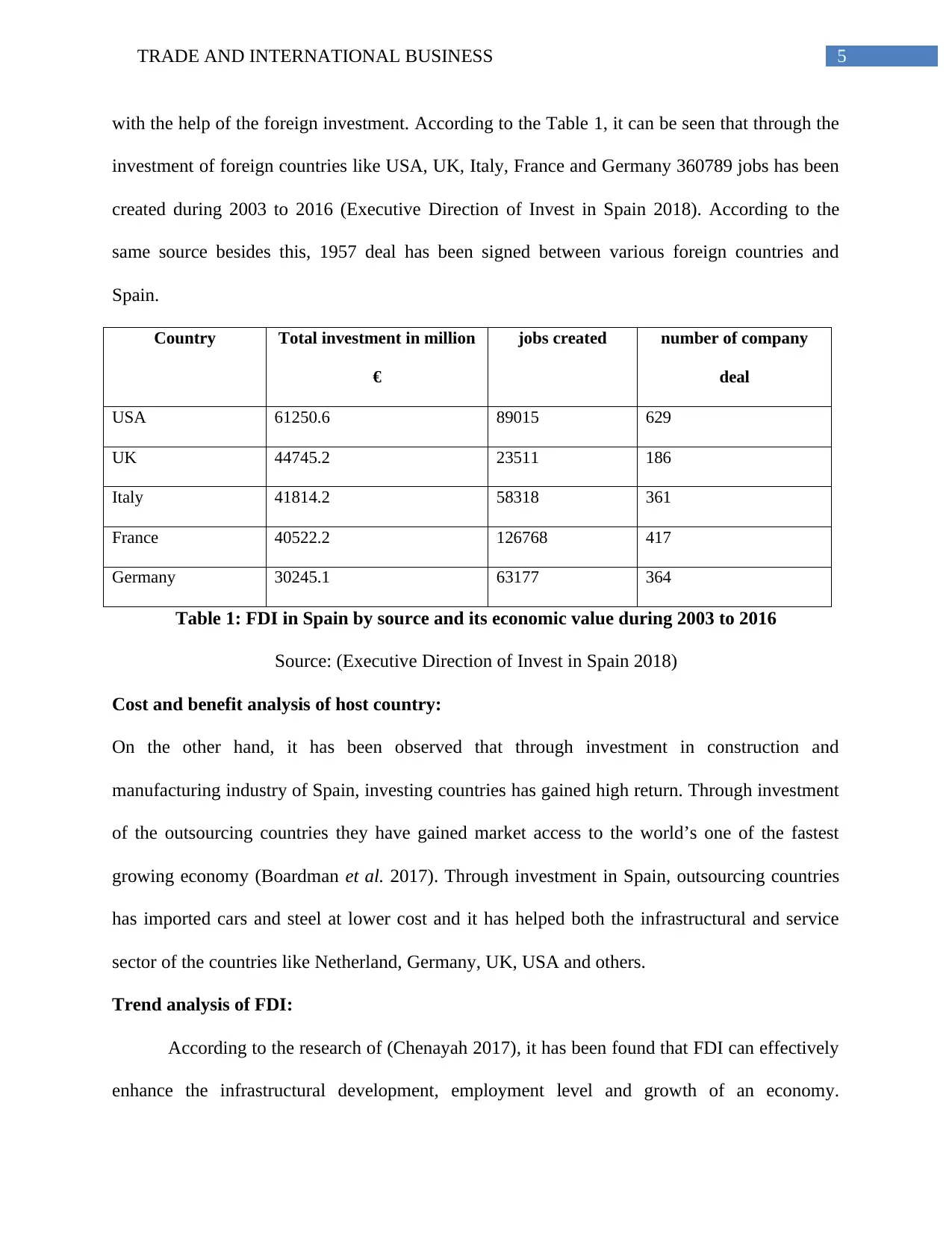
5TRADE AND INTERNATIONAL BUSINESS
with the help of the foreign investment. According to the Table 1, it can be seen that through the
investment of foreign countries like USA, UK, Italy, France and Germany 360789 jobs has been
created during 2003 to 2016 (Executive Direction of Invest in Spain 2018). According to the
same source besides this, 1957 deal has been signed between various foreign countries and
Spain.
Country Total investment in million
€
jobs created number of company
deal
USA 61250.6 89015 629
UK 44745.2 23511 186
Italy 41814.2 58318 361
France 40522.2 126768 417
Germany 30245.1 63177 364
Table 1: FDI in Spain by source and its economic value during 2003 to 2016
Source: (Executive Direction of Invest in Spain 2018)
Cost and benefit analysis of host country:
On the other hand, it has been observed that through investment in construction and
manufacturing industry of Spain, investing countries has gained high return. Through investment
of the outsourcing countries they have gained market access to the world’s one of the fastest
growing economy (Boardman et al. 2017). Through investment in Spain, outsourcing countries
has imported cars and steel at lower cost and it has helped both the infrastructural and service
sector of the countries like Netherland, Germany, UK, USA and others.
Trend analysis of FDI:
According to the research of (Chenayah 2017), it has been found that FDI can effectively
enhance the infrastructural development, employment level and growth of an economy.
with the help of the foreign investment. According to the Table 1, it can be seen that through the
investment of foreign countries like USA, UK, Italy, France and Germany 360789 jobs has been
created during 2003 to 2016 (Executive Direction of Invest in Spain 2018). According to the
same source besides this, 1957 deal has been signed between various foreign countries and
Spain.
Country Total investment in million
€
jobs created number of company
deal
USA 61250.6 89015 629
UK 44745.2 23511 186
Italy 41814.2 58318 361
France 40522.2 126768 417
Germany 30245.1 63177 364
Table 1: FDI in Spain by source and its economic value during 2003 to 2016
Source: (Executive Direction of Invest in Spain 2018)
Cost and benefit analysis of host country:
On the other hand, it has been observed that through investment in construction and
manufacturing industry of Spain, investing countries has gained high return. Through investment
of the outsourcing countries they have gained market access to the world’s one of the fastest
growing economy (Boardman et al. 2017). Through investment in Spain, outsourcing countries
has imported cars and steel at lower cost and it has helped both the infrastructural and service
sector of the countries like Netherland, Germany, UK, USA and others.
Trend analysis of FDI:
According to the research of (Chenayah 2017), it has been found that FDI can effectively
enhance the infrastructural development, employment level and growth of an economy.
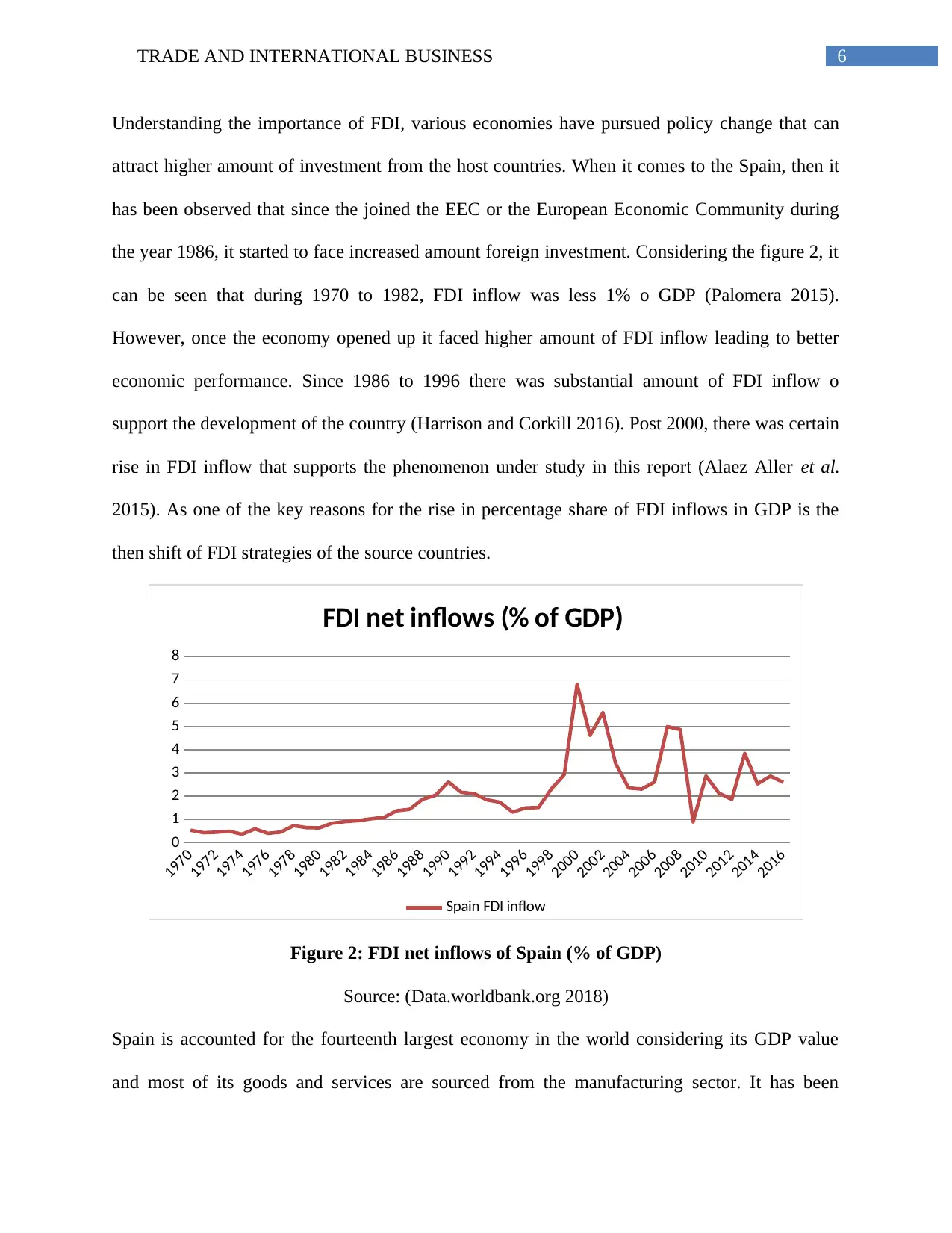
6TRADE AND INTERNATIONAL BUSINESS
Understanding the importance of FDI, various economies have pursued policy change that can
attract higher amount of investment from the host countries. When it comes to the Spain, then it
has been observed that since the joined the EEC or the European Economic Community during
the year 1986, it started to face increased amount foreign investment. Considering the figure 2, it
can be seen that during 1970 to 1982, FDI inflow was less 1% o GDP (Palomera 2015).
However, once the economy opened up it faced higher amount of FDI inflow leading to better
economic performance. Since 1986 to 1996 there was substantial amount of FDI inflow o
support the development of the country (Harrison and Corkill 2016). Post 2000, there was certain
rise in FDI inflow that supports the phenomenon under study in this report (Alaez Aller et al.
2015). As one of the key reasons for the rise in percentage share of FDI inflows in GDP is the
then shift of FDI strategies of the source countries.
1970
1972
1974
1976
1978
1980
1982
1984
1986
1988
1990
1992
1994
1996
1998
2000
2002
2004
2006
2008
2010
2012
2014
2016
0
1
2
3
4
5
6
7
8
FDI net inflows (% of GDP)
Spain FDI inflow
Figure 2: FDI net inflows of Spain (% of GDP)
Source: (Data.worldbank.org 2018)
Spain is accounted for the fourteenth largest economy in the world considering its GDP value
and most of its goods and services are sourced from the manufacturing sector. It has been
Understanding the importance of FDI, various economies have pursued policy change that can
attract higher amount of investment from the host countries. When it comes to the Spain, then it
has been observed that since the joined the EEC or the European Economic Community during
the year 1986, it started to face increased amount foreign investment. Considering the figure 2, it
can be seen that during 1970 to 1982, FDI inflow was less 1% o GDP (Palomera 2015).
However, once the economy opened up it faced higher amount of FDI inflow leading to better
economic performance. Since 1986 to 1996 there was substantial amount of FDI inflow o
support the development of the country (Harrison and Corkill 2016). Post 2000, there was certain
rise in FDI inflow that supports the phenomenon under study in this report (Alaez Aller et al.
2015). As one of the key reasons for the rise in percentage share of FDI inflows in GDP is the
then shift of FDI strategies of the source countries.
1970
1972
1974
1976
1978
1980
1982
1984
1986
1988
1990
1992
1994
1996
1998
2000
2002
2004
2006
2008
2010
2012
2014
2016
0
1
2
3
4
5
6
7
8
FDI net inflows (% of GDP)
Spain FDI inflow
Figure 2: FDI net inflows of Spain (% of GDP)
Source: (Data.worldbank.org 2018)
Spain is accounted for the fourteenth largest economy in the world considering its GDP value
and most of its goods and services are sourced from the manufacturing sector. It has been
Paraphrase This Document
Need a fresh take? Get an instant paraphrase of this document with our AI Paraphraser
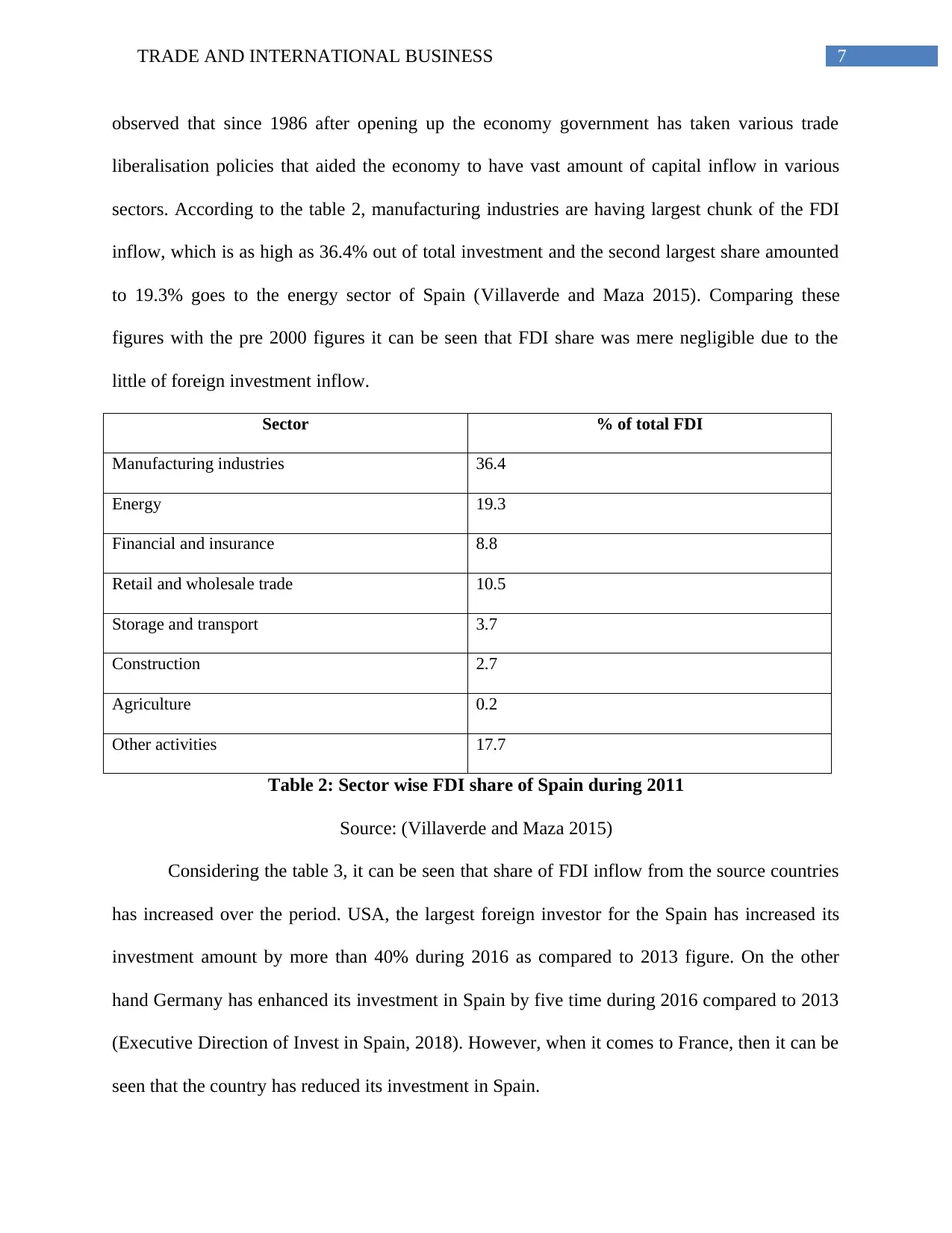
7TRADE AND INTERNATIONAL BUSINESS
observed that since 1986 after opening up the economy government has taken various trade
liberalisation policies that aided the economy to have vast amount of capital inflow in various
sectors. According to the table 2, manufacturing industries are having largest chunk of the FDI
inflow, which is as high as 36.4% out of total investment and the second largest share amounted
to 19.3% goes to the energy sector of Spain (Villaverde and Maza 2015). Comparing these
figures with the pre 2000 figures it can be seen that FDI share was mere negligible due to the
little of foreign investment inflow.
Sector % of total FDI
Manufacturing industries 36.4
Energy 19.3
Financial and insurance 8.8
Retail and wholesale trade 10.5
Storage and transport 3.7
Construction 2.7
Agriculture 0.2
Other activities 17.7
Table 2: Sector wise FDI share of Spain during 2011
Source: (Villaverde and Maza 2015)
Considering the table 3, it can be seen that share of FDI inflow from the source countries
has increased over the period. USA, the largest foreign investor for the Spain has increased its
investment amount by more than 40% during 2016 as compared to 2013 figure. On the other
hand Germany has enhanced its investment in Spain by five time during 2016 compared to 2013
(Executive Direction of Invest in Spain, 2018). However, when it comes to France, then it can be
seen that the country has reduced its investment in Spain.
observed that since 1986 after opening up the economy government has taken various trade
liberalisation policies that aided the economy to have vast amount of capital inflow in various
sectors. According to the table 2, manufacturing industries are having largest chunk of the FDI
inflow, which is as high as 36.4% out of total investment and the second largest share amounted
to 19.3% goes to the energy sector of Spain (Villaverde and Maza 2015). Comparing these
figures with the pre 2000 figures it can be seen that FDI share was mere negligible due to the
little of foreign investment inflow.
Sector % of total FDI
Manufacturing industries 36.4
Energy 19.3
Financial and insurance 8.8
Retail and wholesale trade 10.5
Storage and transport 3.7
Construction 2.7
Agriculture 0.2
Other activities 17.7
Table 2: Sector wise FDI share of Spain during 2011
Source: (Villaverde and Maza 2015)
Considering the table 3, it can be seen that share of FDI inflow from the source countries
has increased over the period. USA, the largest foreign investor for the Spain has increased its
investment amount by more than 40% during 2016 as compared to 2013 figure. On the other
hand Germany has enhanced its investment in Spain by five time during 2016 compared to 2013
(Executive Direction of Invest in Spain, 2018). However, when it comes to France, then it can be
seen that the country has reduced its investment in Spain.

8TRADE AND INTERNATIONAL BUSINESS
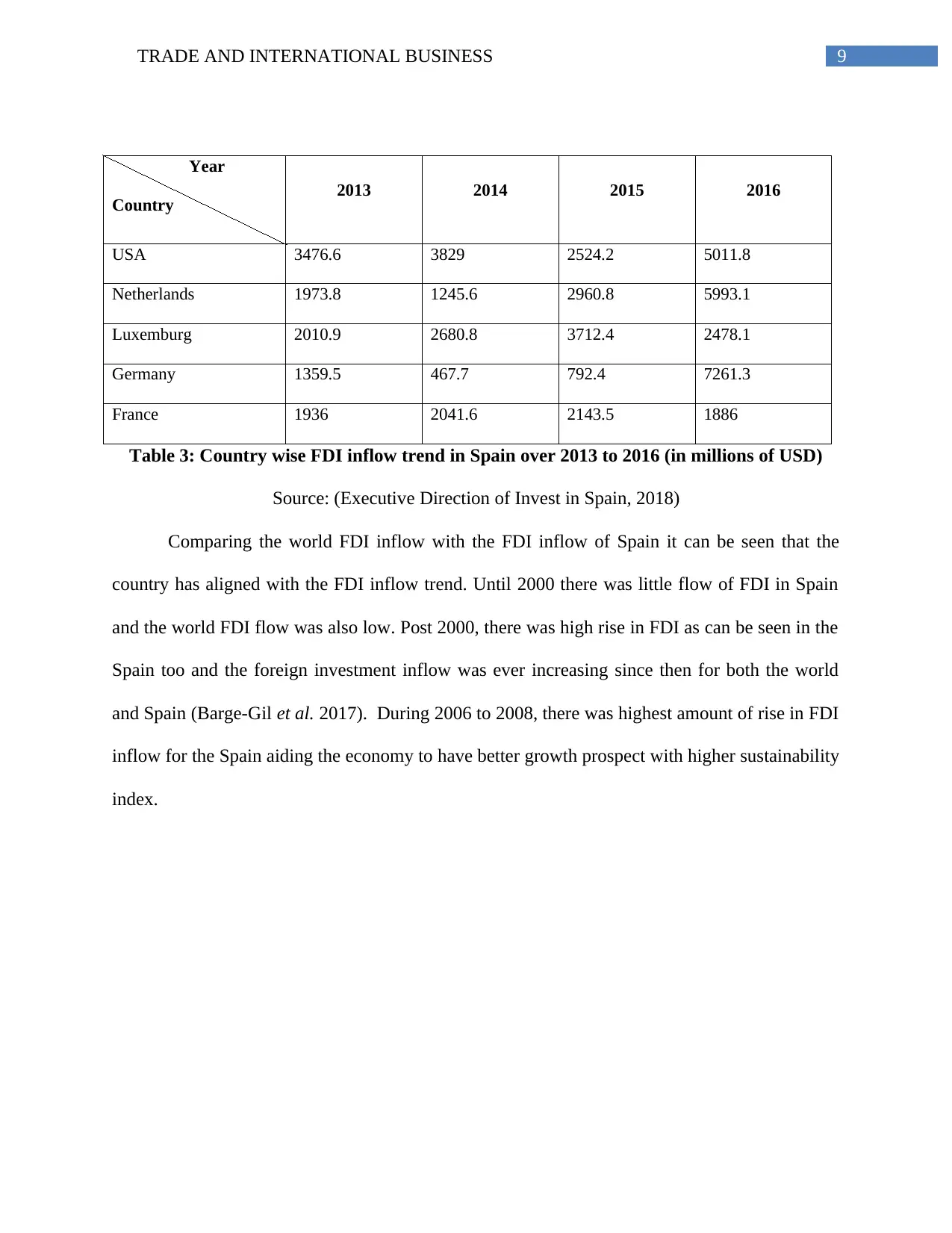
9TRADE AND INTERNATIONAL BUSINESS
Year
Country 2013 2014 2015 2016
USA 3476.6 3829 2524.2 5011.8
Netherlands 1973.8 1245.6 2960.8 5993.1
Luxemburg 2010.9 2680.8 3712.4 2478.1
Germany 1359.5 467.7 792.4 7261.3
France 1936 2041.6 2143.5 1886
Table 3: Country wise FDI inflow trend in Spain over 2013 to 2016 (in millions of USD)
Source: (Executive Direction of Invest in Spain, 2018)
Comparing the world FDI inflow with the FDI inflow of Spain it can be seen that the
country has aligned with the FDI inflow trend. Until 2000 there was little flow of FDI in Spain
and the world FDI flow was also low. Post 2000, there was high rise in FDI as can be seen in the
Spain too and the foreign investment inflow was ever increasing since then for both the world
and Spain (Barge-Gil et al. 2017). During 2006 to 2008, there was highest amount of rise in FDI
inflow for the Spain aiding the economy to have better growth prospect with higher sustainability
index.
Year
Country 2013 2014 2015 2016
USA 3476.6 3829 2524.2 5011.8
Netherlands 1973.8 1245.6 2960.8 5993.1
Luxemburg 2010.9 2680.8 3712.4 2478.1
Germany 1359.5 467.7 792.4 7261.3
France 1936 2041.6 2143.5 1886
Table 3: Country wise FDI inflow trend in Spain over 2013 to 2016 (in millions of USD)
Source: (Executive Direction of Invest in Spain, 2018)
Comparing the world FDI inflow with the FDI inflow of Spain it can be seen that the
country has aligned with the FDI inflow trend. Until 2000 there was little flow of FDI in Spain
and the world FDI flow was also low. Post 2000, there was high rise in FDI as can be seen in the
Spain too and the foreign investment inflow was ever increasing since then for both the world
and Spain (Barge-Gil et al. 2017). During 2006 to 2008, there was highest amount of rise in FDI
inflow for the Spain aiding the economy to have better growth prospect with higher sustainability
index.
Secure Best Marks with AI Grader
Need help grading? Try our AI Grader for instant feedback on your assignments.
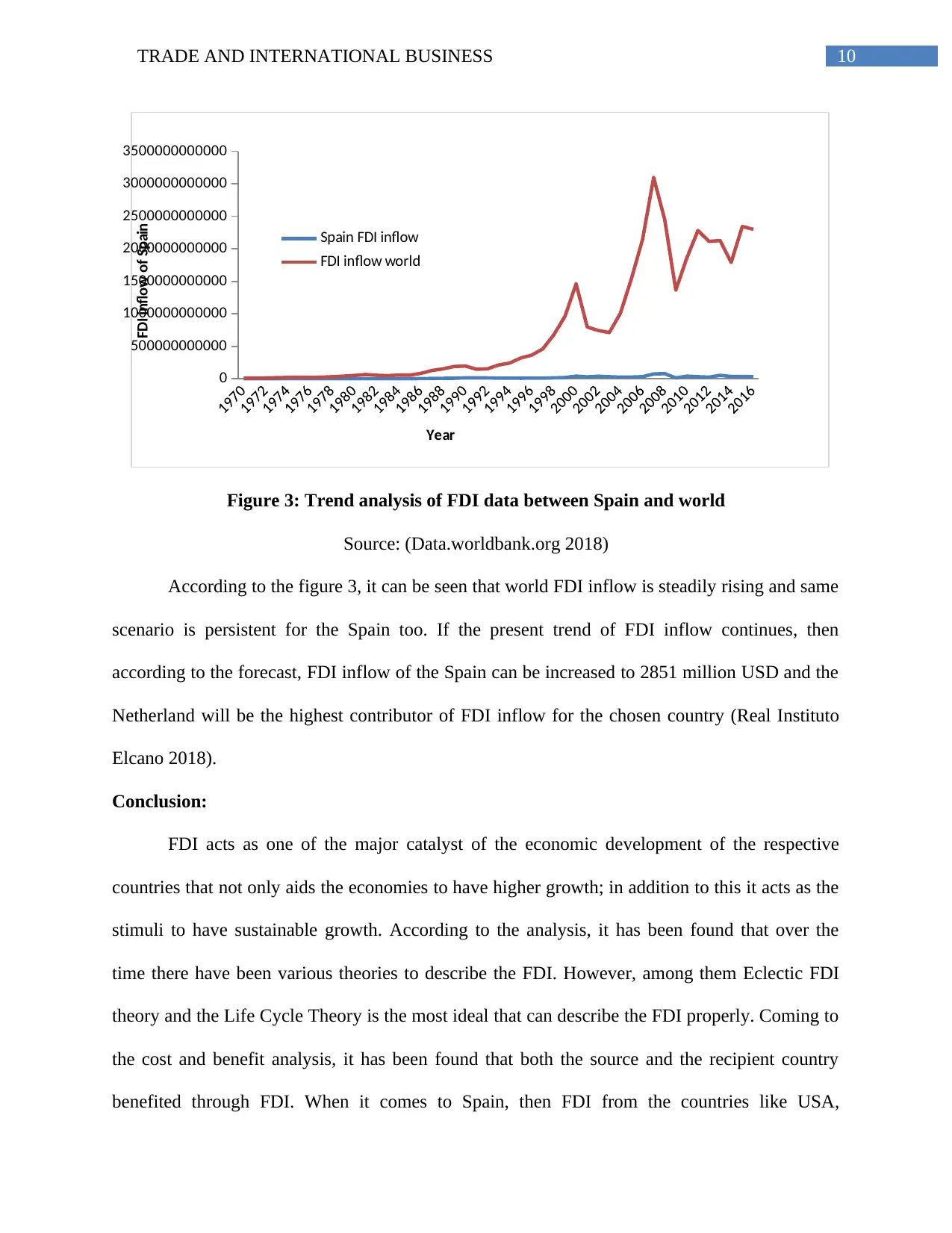
10TRADE AND INTERNATIONAL BUSINESS
0
500000000000
1000000000000
1500000000000
2000000000000
2500000000000
3000000000000
3500000000000
Spain FDI inflow
FDI inflow world
Year
FDI inflow of Spain
Figure 3: Trend analysis of FDI data between Spain and world
Source: (Data.worldbank.org 2018)
According to the figure 3, it can be seen that world FDI inflow is steadily rising and same
scenario is persistent for the Spain too. If the present trend of FDI inflow continues, then
according to the forecast, FDI inflow of the Spain can be increased to 2851 million USD and the
Netherland will be the highest contributor of FDI inflow for the chosen country (Real Instituto
Elcano 2018).
Conclusion:
FDI acts as one of the major catalyst of the economic development of the respective
countries that not only aids the economies to have higher growth; in addition to this it acts as the
stimuli to have sustainable growth. According to the analysis, it has been found that over the
time there have been various theories to describe the FDI. However, among them Eclectic FDI
theory and the Life Cycle Theory is the most ideal that can describe the FDI properly. Coming to
the cost and benefit analysis, it has been found that both the source and the recipient country
benefited through FDI. When it comes to Spain, then FDI from the countries like USA,
0
500000000000
1000000000000
1500000000000
2000000000000
2500000000000
3000000000000
3500000000000
Spain FDI inflow
FDI inflow world
Year
FDI inflow of Spain
Figure 3: Trend analysis of FDI data between Spain and world
Source: (Data.worldbank.org 2018)
According to the figure 3, it can be seen that world FDI inflow is steadily rising and same
scenario is persistent for the Spain too. If the present trend of FDI inflow continues, then
according to the forecast, FDI inflow of the Spain can be increased to 2851 million USD and the
Netherland will be the highest contributor of FDI inflow for the chosen country (Real Instituto
Elcano 2018).
Conclusion:
FDI acts as one of the major catalyst of the economic development of the respective
countries that not only aids the economies to have higher growth; in addition to this it acts as the
stimuli to have sustainable growth. According to the analysis, it has been found that over the
time there have been various theories to describe the FDI. However, among them Eclectic FDI
theory and the Life Cycle Theory is the most ideal that can describe the FDI properly. Coming to
the cost and benefit analysis, it has been found that both the source and the recipient country
benefited through FDI. When it comes to Spain, then FDI from the countries like USA,
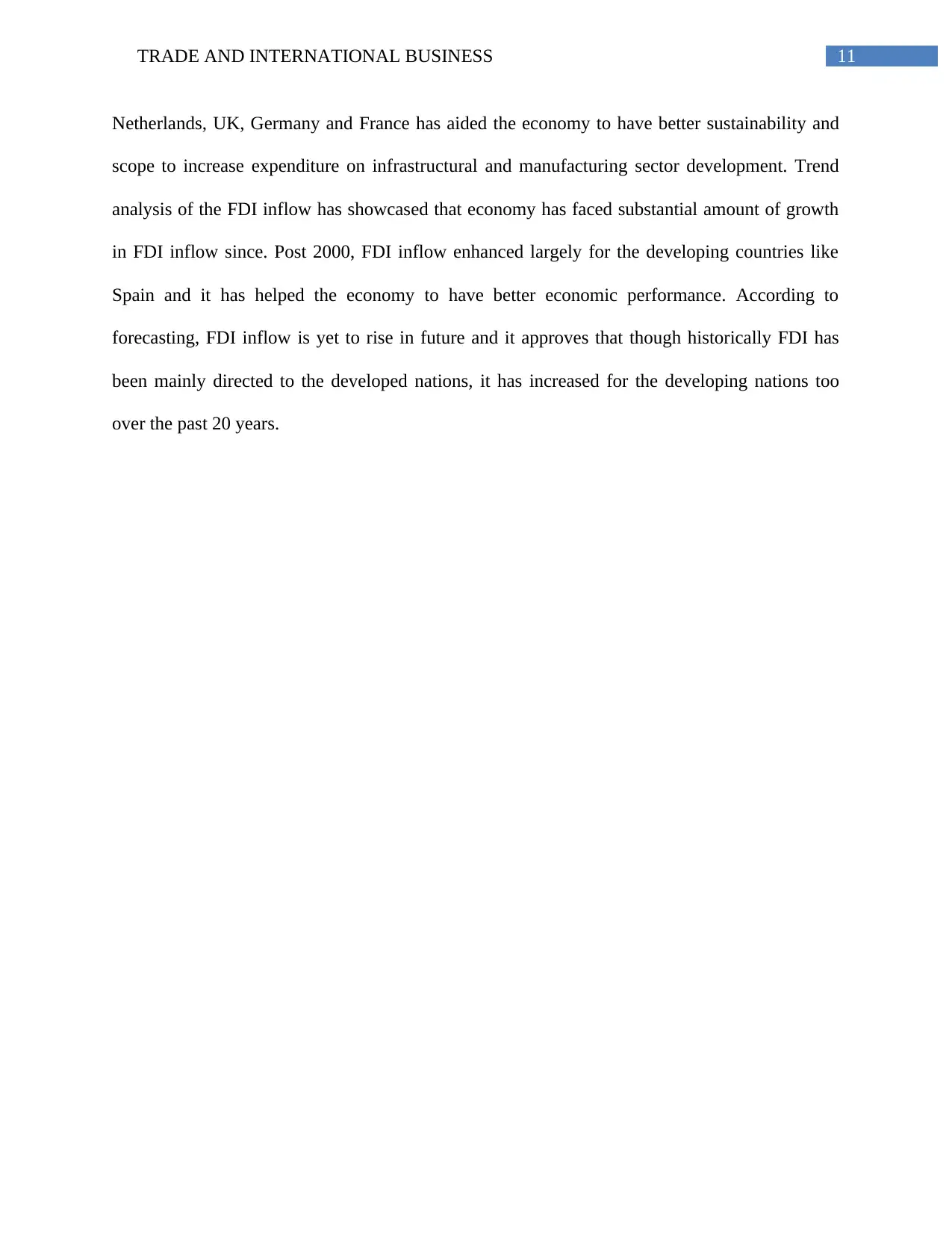
11TRADE AND INTERNATIONAL BUSINESS
Netherlands, UK, Germany and France has aided the economy to have better sustainability and
scope to increase expenditure on infrastructural and manufacturing sector development. Trend
analysis of the FDI inflow has showcased that economy has faced substantial amount of growth
in FDI inflow since. Post 2000, FDI inflow enhanced largely for the developing countries like
Spain and it has helped the economy to have better economic performance. According to
forecasting, FDI inflow is yet to rise in future and it approves that though historically FDI has
been mainly directed to the developed nations, it has increased for the developing nations too
over the past 20 years.
Netherlands, UK, Germany and France has aided the economy to have better sustainability and
scope to increase expenditure on infrastructural and manufacturing sector development. Trend
analysis of the FDI inflow has showcased that economy has faced substantial amount of growth
in FDI inflow since. Post 2000, FDI inflow enhanced largely for the developing countries like
Spain and it has helped the economy to have better economic performance. According to
forecasting, FDI inflow is yet to rise in future and it approves that though historically FDI has
been mainly directed to the developed nations, it has increased for the developing nations too
over the past 20 years.
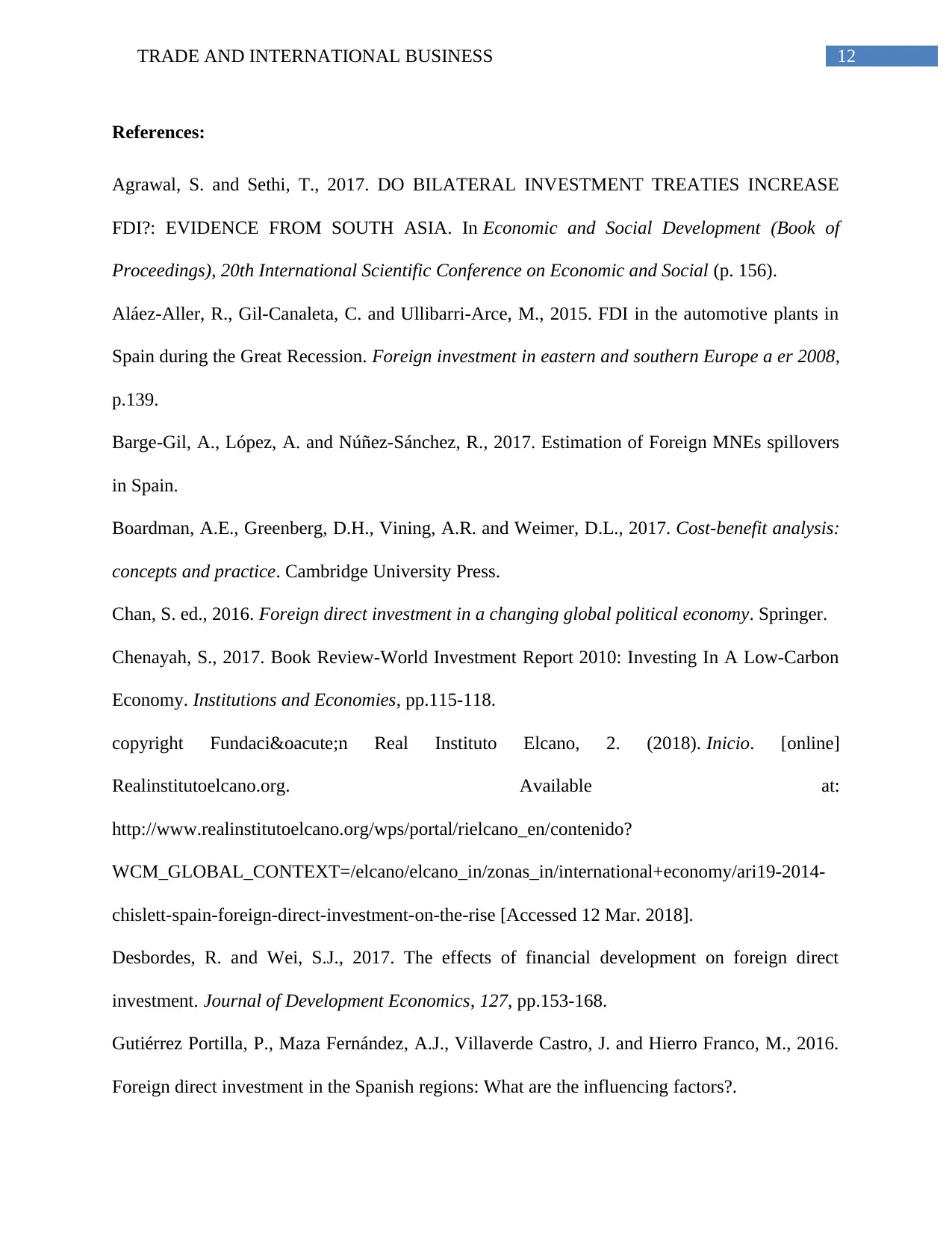
12TRADE AND INTERNATIONAL BUSINESS
References:
Agrawal, S. and Sethi, T., 2017. DO BILATERAL INVESTMENT TREATIES INCREASE
FDI?: EVIDENCE FROM SOUTH ASIA. In Economic and Social Development (Book of
Proceedings), 20th International Scientific Conference on Economic and Social (p. 156).
Aláez-Aller, R., Gil-Canaleta, C. and Ullibarri-Arce, M., 2015. FDI in the automotive plants in
Spain during the Great Recession. Foreign investment in eastern and southern Europe a er 2008,
p.139.
Barge-Gil, A., López, A. and Núñez-Sánchez, R., 2017. Estimation of Foreign MNEs spillovers
in Spain.
Boardman, A.E., Greenberg, D.H., Vining, A.R. and Weimer, D.L., 2017. Cost-benefit analysis:
concepts and practice. Cambridge University Press.
Chan, S. ed., 2016. Foreign direct investment in a changing global political economy. Springer.
Chenayah, S., 2017. Book Review-World Investment Report 2010: Investing In A Low-Carbon
Economy. Institutions and Economies, pp.115-118.
copyright Fundación Real Instituto Elcano, 2. (2018). Inicio. [online]
Realinstitutoelcano.org. Available at:
http://www.realinstitutoelcano.org/wps/portal/rielcano_en/contenido?
WCM_GLOBAL_CONTEXT=/elcano/elcano_in/zonas_in/international+economy/ari19-2014-
chislett-spain-foreign-direct-investment-on-the-rise [Accessed 12 Mar. 2018].
Desbordes, R. and Wei, S.J., 2017. The effects of financial development on foreign direct
investment. Journal of Development Economics, 127, pp.153-168.
Gutiérrez Portilla, P., Maza Fernández, A.J., Villaverde Castro, J. and Hierro Franco, M., 2016.
Foreign direct investment in the Spanish regions: What are the influencing factors?.
References:
Agrawal, S. and Sethi, T., 2017. DO BILATERAL INVESTMENT TREATIES INCREASE
FDI?: EVIDENCE FROM SOUTH ASIA. In Economic and Social Development (Book of
Proceedings), 20th International Scientific Conference on Economic and Social (p. 156).
Aláez-Aller, R., Gil-Canaleta, C. and Ullibarri-Arce, M., 2015. FDI in the automotive plants in
Spain during the Great Recession. Foreign investment in eastern and southern Europe a er 2008,
p.139.
Barge-Gil, A., López, A. and Núñez-Sánchez, R., 2017. Estimation of Foreign MNEs spillovers
in Spain.
Boardman, A.E., Greenberg, D.H., Vining, A.R. and Weimer, D.L., 2017. Cost-benefit analysis:
concepts and practice. Cambridge University Press.
Chan, S. ed., 2016. Foreign direct investment in a changing global political economy. Springer.
Chenayah, S., 2017. Book Review-World Investment Report 2010: Investing In A Low-Carbon
Economy. Institutions and Economies, pp.115-118.
copyright Fundación Real Instituto Elcano, 2. (2018). Inicio. [online]
Realinstitutoelcano.org. Available at:
http://www.realinstitutoelcano.org/wps/portal/rielcano_en/contenido?
WCM_GLOBAL_CONTEXT=/elcano/elcano_in/zonas_in/international+economy/ari19-2014-
chislett-spain-foreign-direct-investment-on-the-rise [Accessed 12 Mar. 2018].
Desbordes, R. and Wei, S.J., 2017. The effects of financial development on foreign direct
investment. Journal of Development Economics, 127, pp.153-168.
Gutiérrez Portilla, P., Maza Fernández, A.J., Villaverde Castro, J. and Hierro Franco, M., 2016.
Foreign direct investment in the Spanish regions: What are the influencing factors?.
Paraphrase This Document
Need a fresh take? Get an instant paraphrase of this document with our AI Paraphraser
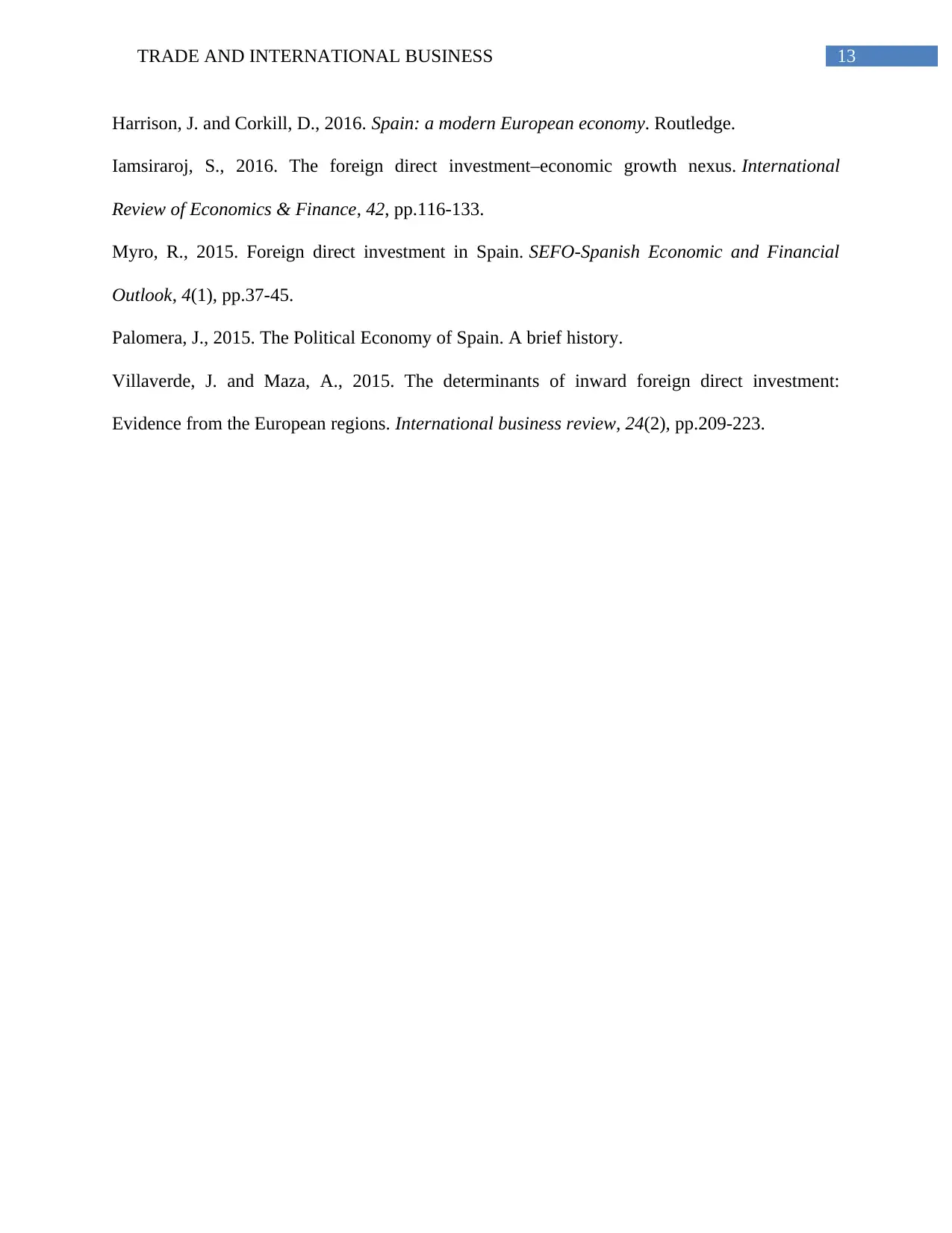
13TRADE AND INTERNATIONAL BUSINESS
Harrison, J. and Corkill, D., 2016. Spain: a modern European economy. Routledge.
Iamsiraroj, S., 2016. The foreign direct investment–economic growth nexus. International
Review of Economics & Finance, 42, pp.116-133.
Myro, R., 2015. Foreign direct investment in Spain. SEFO-Spanish Economic and Financial
Outlook, 4(1), pp.37-45.
Palomera, J., 2015. The Political Economy of Spain. A brief history.
Villaverde, J. and Maza, A., 2015. The determinants of inward foreign direct investment:
Evidence from the European regions. International business review, 24(2), pp.209-223.
Harrison, J. and Corkill, D., 2016. Spain: a modern European economy. Routledge.
Iamsiraroj, S., 2016. The foreign direct investment–economic growth nexus. International
Review of Economics & Finance, 42, pp.116-133.
Myro, R., 2015. Foreign direct investment in Spain. SEFO-Spanish Economic and Financial
Outlook, 4(1), pp.37-45.
Palomera, J., 2015. The Political Economy of Spain. A brief history.
Villaverde, J. and Maza, A., 2015. The determinants of inward foreign direct investment:
Evidence from the European regions. International business review, 24(2), pp.209-223.
1 out of 14
Related Documents
Your All-in-One AI-Powered Toolkit for Academic Success.
+13062052269
info@desklib.com
Available 24*7 on WhatsApp / Email
![[object Object]](/_next/static/media/star-bottom.7253800d.svg)
Unlock your academic potential
© 2024 | Zucol Services PVT LTD | All rights reserved.




